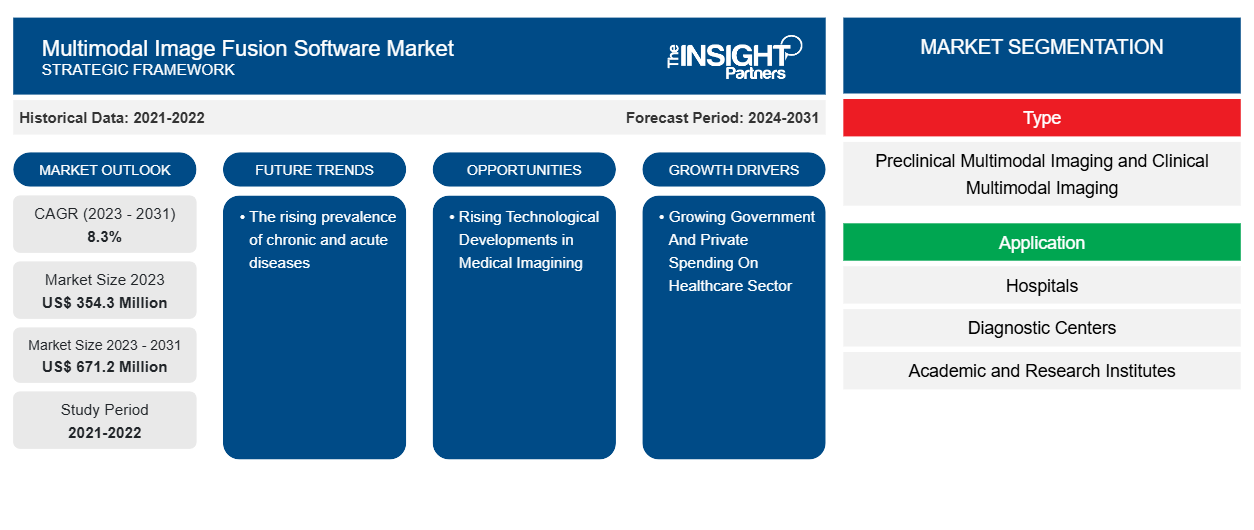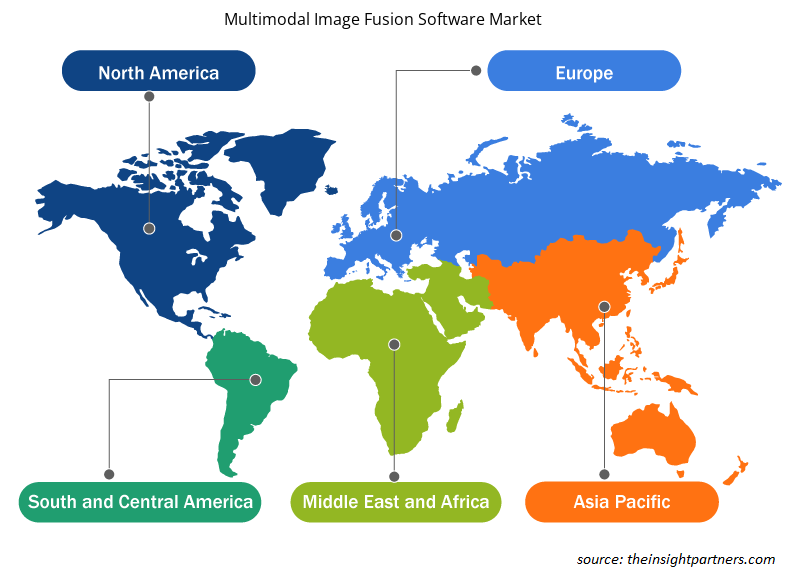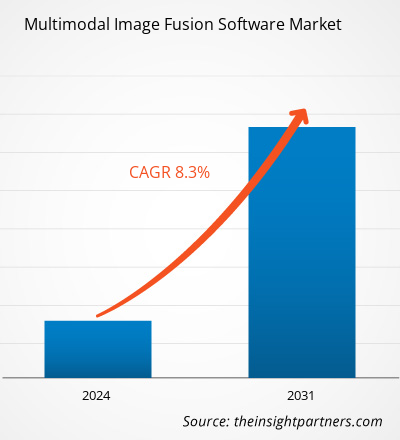The multimodal image fusion software market size is projected to reach US$ 671.2 million by 2031 from US$ 354.3 million in 2023. The market is expected to register a CAGR of 8.3% during 2023–2031. The rising prevalence of chronic and acute diseases is likely to remain a key trend in the market.
Multimodal Image Fusion Software Market Analysis
Multimodal image fusion software can produce a more full and accurate view of the scene by fusing numerous characteristics of imaging data, which aids in decision-making and enhances end-to-end system performance. Furthermore, multimodal imaging data can aid decision-making and system performance. The need for multimodal image fusion technology is continually expanding due to its wide range of applications. For example, in medical imaging, multimodal image fusion can aid in enhancing diagnosis and treatment planning by merging information from various imaging modalities.
Multimodal Image Fusion Software Market Overview
Multimodal image fusion software tries to combine important information from images captured by several sensors into a single image. The fused images are expected to maintain all of the critical information from the original photos while introducing no distortions or artifacts. Multimodal image fusion software is projected to play an important role in several applications, including autonomous driving, surveillance systems, and robotics. Integrating data from many sources enables these systems to operate in complex and dynamic contexts, increasing efficiency, reliability, and safety.
Customize This Report To Suit Your Requirement
You will get customization on any report - free of charge - including parts of this report, or country-level analysis, Excel Data pack, as well as avail great offers and discounts for start-ups & universities
Multimodal Image Fusion Software Market: Strategic Insights

- Get Top Key Market Trends of this report.This FREE sample will include data analysis, ranging from market trends to estimates and forecasts.
You will get customization on any report - free of charge - including parts of this report, or country-level analysis, Excel Data pack, as well as avail great offers and discounts for start-ups & universities
Multimodal Image Fusion Software Market: Strategic Insights

- Get Top Key Market Trends of this report.This FREE sample will include data analysis, ranging from market trends to estimates and forecasts.
Multimodal Image Fusion Software Market Drivers and Opportunities
Growing Government And Private Spending On Healthcare Sector to Favor Market
The government and private spending on the healthcare sector is growing continuously in response to better public health. For example, according to the U.S. Centers for Medicare & Medicaid Services, National National Health Expenditure (NHE) grew 4.1% to US $4.5 trillion in 2022, or $13,493 per person. It accounted for 17.3% of Gross Domestic Product (GDP). Medicare spending grew 5.9% to $944.3 billion in 2022, or 21 percent of total NHE. 2021. Further, the largest shares of total health spending in the US were sponsored by the federal government (33 %) and households (28 %). The private business share of health spending accounted for 18 % of total healthcare spending, state and local governments accounted for 15 %, and other private revenues accounted for 7 %. Multimodal image fusion plays a vital role in the medical industry. It is designed exclusively for medical imagery. This strategy aims to make medical imaging more clinically relevant for the examination and assessment of health conditions by decreasing unnecessary work and enhancing quality. It allows for a more accurate diagnosis and streamlines the diagnostic process. In medical image fusion (MIF), an intuitionistic fuzzy set (IFS) helps to improve image quality, which is useful for medical diagnosis. Thus, the growing spending by government and private spending on the healthcare sector is driving the growth of the market.
Rising Technological Developments in Medical Imagining
Medical imaging technologies are constantly evolving, resulting in new applications for illness diagnosis and treatment. New medical imaging technologies promise to directly enhance patient outcomes. Innovative medical imaging technologies promise to enhance patient outcomes in a variety of ways. For example, mobile imaging devices can monitor and diagnose elderly patients without requiring an in-person medical session. Wearable medical gadgets that include imaging components make it easier and more convenient for patients to report vital facts due to which Medical researchers are leveraging artificial intelligence (AI), virtual reality (VR), wearable computers, and other technological advancements to improve healthcare. Computers may imitate real-world circumstances in ways that allow humans to gain fresh ideas and views that are beyond their sensory awareness. Furthermore, multimodal image fusion can assist in detecting and treating complex disorders by merging information from multiple imaging modalities such as computed tomography (CT) and magnetic resonance imaging (MRI).
Multimodal Image Fusion Software Market Report Segmentation Analysis
Key segments that contributed to the derivation of the multimodal image fusion software market analysis are type and application.
- Based on type, the multimodal image fusion software market is segmented into preclinical multimodal imaging and clinical multimodal imaging.
- In terms of application, the market is segmented into hospitals, diagnostic centers, and academic and research institutes.
Multimodal Image Fusion Software Market Share Analysis by Geography
The geographic scope of the multimodal image fusion software market report is mainly divided into five regions: North America, Asia Pacific, Europe, Middle East & Africa, and South & Central America. As hospitals and healthcare providers across North America work to digitize their procedures, the demand for skilled healthcare software development businesses grows. This post includes a list of notable healthcare software development organizations that are ready to achieve transformational change. The North American region dominates the software adoption in healthcare and others, owing to its high adoption rate of innovative medical software solutions and a big patient population, ensuring its dominance during the projection period. Such instances create lucrative opportunities for the growth of the market.
Multimodal Image Fusion Software Market Regional Insights
The regional trends and factors influencing the Multimodal Image Fusion Software Market throughout the forecast period have been thoroughly explained by the analysts at The Insight Partners. This section also discusses Multimodal Image Fusion Software Market segments and geography across North America, Europe, Asia Pacific, Middle East and Africa, and South and Central America.

- Get the Regional Specific Data for Multimodal Image Fusion Software Market
Multimodal Image Fusion Software Market Report Scope
| Report Attribute | Details |
|---|---|
| Market size in 2023 | US$ 354.3 Million |
| Market Size by 2031 | US$ 671.2 Million |
| Global CAGR (2023 - 2031) | 8.3% |
| Historical Data | 2021-2022 |
| Forecast period | 2024-2031 |
| Segments Covered |
By Type
|
| Regions and Countries Covered | North America
|
| Market leaders and key company profiles |
Multimodal Image Fusion Software Market Players Density: Understanding Its Impact on Business Dynamics
The Multimodal Image Fusion Software Market is growing rapidly, driven by increasing end-user demand due to factors such as evolving consumer preferences, technological advancements, and greater awareness of the product's benefits. As demand rises, businesses are expanding their offerings, innovating to meet consumer needs, and capitalizing on emerging trends, which further fuels market growth.
Market players density refers to the distribution of firms or companies operating within a particular market or industry. It indicates how many competitors (market players) are present in a given market space relative to its size or total market value.
Major Companies operating in the Multimodal Image Fusion Software Market are:
- aycan Medical Systems, LLC
- Brainlab AG
- Bruker Corporation
- FUJIFILM VisualSonics, Inc.
- INFINITT North America Inc.
- Mediso Ltd
Disclaimer: The companies listed above are not ranked in any particular order.

- Get the Multimodal Image Fusion Software Market top key players overview
Multimodal Image Fusion Software Market News and Recent Developments
The multimodal image fusion software market is evaluated by gathering qualitative and quantitative data post primary and secondary research, which includes important corporate publications, association data, and databases. A few of the developments in the multimodal image fusion software market are listed below:
- Intrasense SA has released a new version of Myrian 2.9, which has been released. The new version of the medical imaging software had a more focus on new clinical features. (Source: Intrasense SA, April 2021)
- Bruker Corporation (Nasdaq: BRKR) announced the launch of a novel, high-performance MALDI-TOF/TOF system, the neofleX Imaging Profiler for mass spectrometry-based tissue imaging. It enables facile OME-TIFF file output via the new SCiLS Scope software. The transformative neofleX MALDI-TOF/TOF MSI system now conveniently fits on a benchtop. (Source: Bruker Corporation, June 2024)
Multimodal Image Fusion Software Market Report Coverage and Deliverables
The “Multimodal Image Fusion Software Market Size and Forecast (2021–2031)” report provides a detailed analysis of the market covering below areas:
- Multimodal image fusion software market size and forecast at global, regional, and country levels for all the key market segments covered under the scope
- Multimodal image fusion software market trends as well as market dynamics such as drivers, restraints, and key opportunities
- Detailed PEST/Porter’s Five Forces and SWOT analysis
- Multimodal image fusion software market analysis covering key market trends, global and regional framework, major players, regulations, and recent market developments
- Industry landscape and competition analysis covering market concentration, heat map analysis, prominent players, and recent developments for the multimodal image fusion software market
- Detailed company profiles.
Frequently Asked Questions
What is the expected CAGR of the multimodal image fusion software market?
The market is expected to register a CAGR of 8.3% during 2023–2031
What would be the estimated value of the multimodal image fusion software market by 2031?
The global multimodal image fusion software market is expected to reach US$ 671.2 million by 2031.
Which are the leading players operating in the multimodal image fusion software market?
The leading players operating in the global multimodal image fusion software market are Aycan Medical Systems, LLC, Brainlab AG, Bruker Corporation, FUJIFILM VisualSonics, Inc., INFINITT North America Inc., Mediso Ltd, PerkinElmer, Inc., Carl Zeiss Meditec, MR Solutions Ltd., and Intrasense SA.
What are the future trends of the multimodal image fusion software market?
The rising prevalence of chronic and acute diseases to play a significant role in the global multimodal image fusion software market in the coming years.
What are the driving factors impacting the multimodal image fusion software market?
Growing government and private spending on the healthcare sector is the major factors that propel the global multimodal image fusion software market.
Which region dominated the multimodal image fusion software market in 2023?
North America region dominated the multimodal image fusion software market in 2023.
- Historical Analysis (2 Years), Base Year, Forecast (7 Years) with CAGR
- PEST and SWOT Analysis
- Market Size Value / Volume - Global, Regional, Country
- Industry and Competitive Landscape
- Excel Dataset
- Parking Meter Apps Market
- eSIM Market
- Advanced Distributed Management System Market
- Online Exam Proctoring Market
- Electronic Data Interchange Market
- Barcode Software Market
- Maritime Analytics Market
- Cloud Manufacturing Execution System (MES) Market
- Robotic Process Automation Market
- Digital Signature Market
Testimonials
Reason to Buy
- Informed Decision-Making
- Understanding Market Dynamics
- Competitive Analysis
- Identifying Emerging Markets
- Customer Insights
- Market Forecasts
- Risk Mitigation
- Boosting Operational Efficiency
- Strategic Planning
- Investment Justification
- Tracking Industry Innovations
- Aligning with Regulatory Trends
Yes! We provide a free sample of the report, which includes Report Scope (Table of Contents), report structure, and selected insights to help you assess the value of the full report. Please click on the "Download Sample" button or contact us to receive your copy.
Absolutely — analyst assistance is part of the package. You can connect with our analyst post-purchase to clarify report insights, methodology or discuss how the findings apply to your business needs.
Once your order is successfully placed, you will receive a confirmation email along with your invoice.
• For published reports: You’ll receive access to the report within 4–6 working hours via a secured email sent to your email.
• For upcoming reports: Your order will be recorded as a pre-booking. Our team will share the estimated release date and keep you informed of any updates. As soon as the report is published, it will be delivered to your registered email.
We offer customization options to align the report with your specific objectives. Whether you need deeper insights into a particular region, industry segment, competitor analysis, or data cut, our research team can tailor the report accordingly. Please share your requirements with us, and we’ll be happy to provide a customized proposal or scope.
The report is available in either PDF format or as an Excel dataset, depending on the license you choose.
The PDF version provides the full analysis and visuals in a ready-to-read format. The Excel dataset includes all underlying data tables for easy manipulation and further analysis.
Please review the license options at checkout or contact us to confirm which formats are included with your purchase.
Our payment process is fully secure and PCI-DSS compliant.
We use trusted and encrypted payment gateways to ensure that all transactions are protected with industry-standard SSL encryption. Your payment details are never stored on our servers and are handled securely by certified third-party processors.
You can make your purchase with confidence, knowing your personal and financial information is safe with us.
Yes, we do offer special pricing for bulk purchases.
If you're interested in purchasing multiple reports, we’re happy to provide a customized bundle offer or volume-based discount tailored to your needs. Please contact our sales team with the list of reports you’re considering, and we’ll share a personalized quote.
Yes, absolutely.
Our team is available to help you make an informed decision. Whether you have questions about the report’s scope, methodology, customization options, or which license suits you best, we’re here to assist. Please reach out to us at sales@theinsightpartners.com, and one of our representatives will get in touch promptly.
Yes, a billing invoice will be automatically generated and sent to your registered email upon successful completion of your purchase.
If you need the invoice in a specific format or require additional details (such as company name, GST, or VAT information), feel free to contact us, and we’ll be happy to assist.
Yes, certainly.
If you encounter any difficulties accessing or receiving your report, our support team is ready to assist you. Simply reach out to us via email or live chat with your order information, and we’ll ensure the issue is resolved quickly so you can access your report without interruption.





















 Get Free Sample For
Get Free Sample For